GIGABYTE GA-J1800N-D2H Review: Dual Core Bay Trail-D at $69
by Ian Cutress on December 26, 2014 11:00 AM EST- Posted in
- Motherboards
- Intel
- Bay Trail
CPU Performance
Readers of our motherboard review section will have noted the trend in modern motherboards to implement a form of MultiCore Enhancement / Acceleration / Turbo (read our report here) on their motherboards. This does several things, including better benchmark results at stock settings (not entirely needed if overclocking is an end-user goal) at the expense of heat and temperature. It also gives in essence an automatic overclock which may be against what the user wants. Our testing methodology is ‘out-of-the-box’, with the latest public BIOS installed and XMP enabled, and thus subject to the whims of this feature. It is ultimately up to the motherboard manufacturer to take this risk – and manufacturers taking risks in the setup is something they do on every product (think C-state settings, USB priority, DPC Latency / monitoring priority, memory subtimings at JEDEC). Processor speed change is part of that risk, and ultimately if no overclocking is planned, some motherboards will affect how fast that shiny new processor goes and can be an important factor in the system build.
For reference, the J1800N-D2H does not use any form of MultiCore Turbo.
Point Calculations – 3D Movement Algorithm Test: link
3DPM is a self-penned benchmark, taking basic 3D movement algorithms used in Brownian Motion simulations and testing them for speed. High floating point performance, MHz and IPC wins in the single thread version, whereas the multithread version has to handle the threads and loves more cores. For a brief explanation of the platform agnostic coding behind this benchmark, see my forum post here.
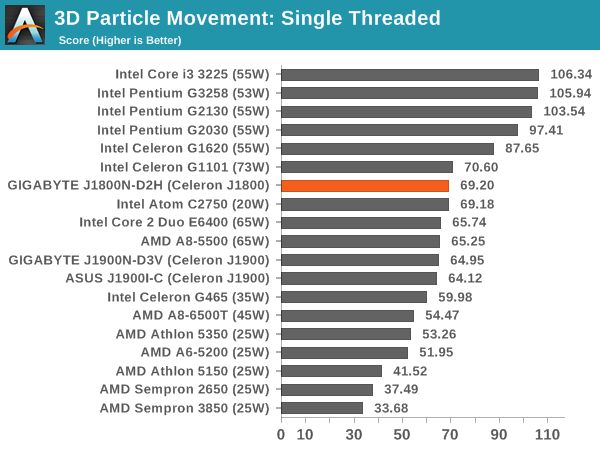
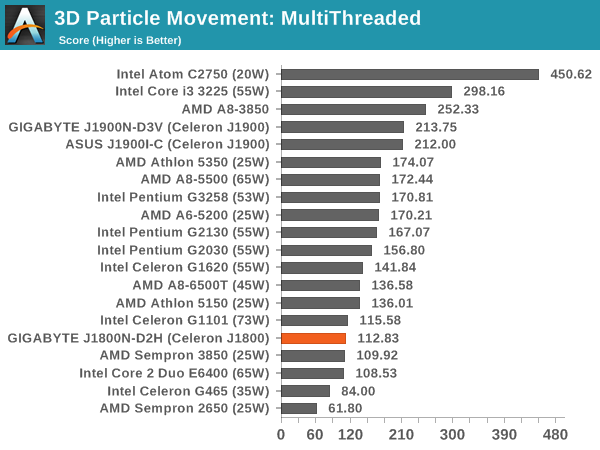
Compression – WinRAR 5.0.1: link
Our WinRAR test from 2013 is updated to the latest version of WinRAR at the start of 2014. We compress a set of 2867 files across 320 folders totaling 1.52 GB in size – 95% of these files are small typical website files, and the rest (90% of the size) are small 30 second 720p videos.
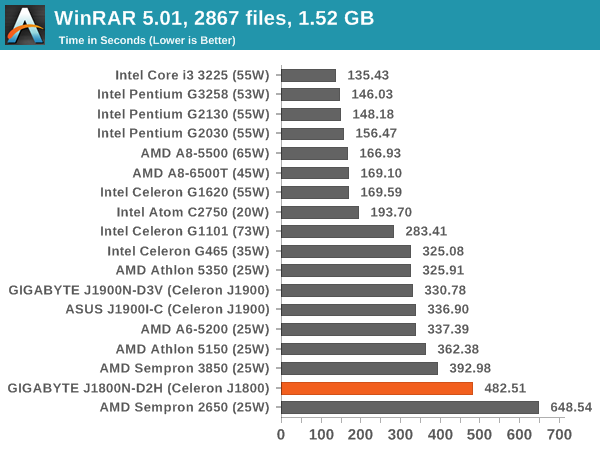
Image Manipulation – FastStone Image Viewer 4.9: link
Similarly to WinRAR, the FastStone test us updated for 2014 to the latest version. FastStone is the program I use to perform quick or bulk actions on images, such as resizing, adjusting for color and cropping. In our test we take a series of 170 images in various sizes and formats and convert them all into 640x480 .gif files, maintaining the aspect ratio. FastStone does not use multithreading for this test, and thus single threaded performance is often the winner.
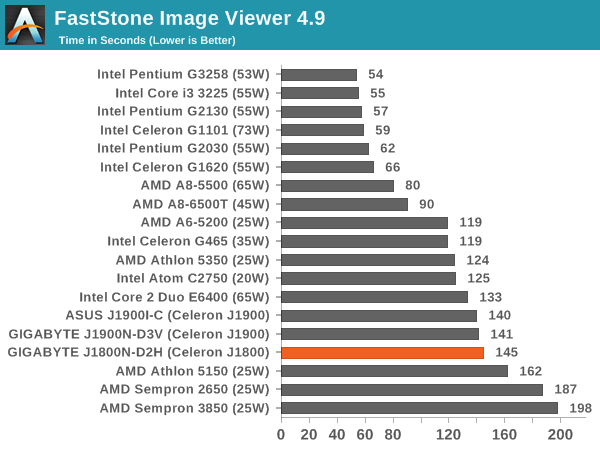
Synthetic – 7-Zip 9.2: link
As an open source compression tool, 7-Zip is a popular tool for making sets of files easier to handle and transfer. The software offers up its own benchmark, to which we report the result.
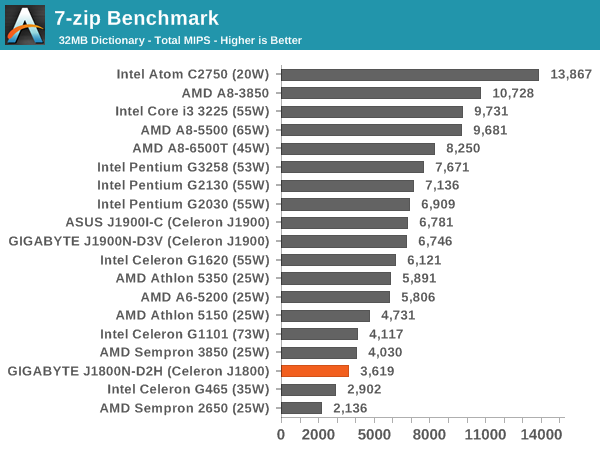










38 Comments
View All Comments
jbltecnicspro - Saturday, December 27, 2014 - link
Good article, but I really would have appreciated if you could compare this CPU to a Celeron 1037u. I have a feeling that with its Ivy Bridge architecture though, that it would probably wipe the floor with this new CPU.bill.rookard - Saturday, December 27, 2014 - link
You'd be right on the dual core version. Compared against the little quad core version, the quad does significantly better. I have to say that I wouldn't consider the dual core for any purchase, but I do have the quad in my htpc. The quad has slower single thread performance, but the total score (geekbench) using all cores matches the 1037u.jbltecnicspro - Saturday, December 27, 2014 - link
Interesting. Thanks for sharing your experiences. I have to wonder though, when I see a 1037u + motherboard system for sale for like $4 extra dollars, what's Intel's point in releasing this? I suppose eventually when the supply for the 1037u dries up, all we'll have are these Atoms. Hurray - we're paying more for less. :)bill.rookard - Saturday, December 27, 2014 - link
Well, I do agree on some puzzlement as to what purpose the J1800 serves. The J1800 is a 10w part, the J1900 is a 10w part. Geekbench on the J1800 is about 1000 on the single core (matching the J1900) but only 1600 on the multicore score. That is pretty useless and would be somewhat painful to use in real life.And - considering that the J1900 scores much higher on the multi-core loads while operating in the same thermal envelope, they can't even say that it's really and issue of power usage in a mobile situation. So, I can see why they would release the J1900 quad, it turns in similar performance metrics as the 1037u while using half the power which is a worthwhile cause.
The J1800 seems to be a 'broken quad core' part that they're releasing to keep yields high as they sell them to suckers who don't realize how slow they are.
nginx - Friday, January 2, 2015 - link
There would have been a huge market for these if they had the intuition to slot in a couple of extra SATA ports. It would have made for a super cheap 4 bay NAS with extremely low power consumption. Would have easily been the next gen successor to the 1037u for the DIY NAS builders.In its current state, it might only appeal to the HTPC builders if it can do transconding on the fly. For those of us who don't need transcoding on the fly, the Raspberry Pi is the perfect solution.
A secondary market could be those looking for a PC just to surf the net and do light office work but with a score of 1000, even those tasks could be a handful for the J1800. I have a 7 year old Core2Duo laptop with 1083 score and it feels too sluggish for daily use even with an SSD.
flensr - Saturday, December 27, 2014 - link
the price link to the dell monitor goes to the amazon search for the viewsonic monitor.eanazag - Tuesday, January 13, 2015 - link
Okay, so are you using UEFI in Windows 7? This obviously affects POST time. Also Windows 8 POST times with UEFI would be the best case scenario in testing. If I care about POST times, I will be running Windows 8.I remember that there have been benches done with Anandtech on Windows 8. Why not across the board?